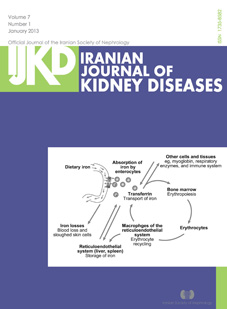Monitoring of Intraocular Pressure and Its Correlation With Systemic Parameters Before and After Hemodialysis
Abstract
Introduction. End-stage renal disease and hemodialysis affect intraocular pressure (IOP). This study aimed to evaluate the effects of a one session of hemodialysis on IOP.
Materials and Methods. In this study, the IOP of 130 eyes of 65 hemodialysis patients (38 men and 27 women) was measured before and every 1 hour after the initiation of hemodialysis therapy. Patients with any glaucomatous conditions were excluded. Demographic information including age, gender, underling systemic or ocular diseases, hemodialysis duration and frequency, KT/V, and levels of blood pressure, body weight, blood urea, serum sodium, serum potassium, blood glucose before and after hemodialysis were recorded.
Results. The mean age of the patients was 60.3 ± 16.7 years. The mean predialysis and postdialysis IOPs were 13.50 ± 4.09 mm Hg and 12.73 ± 4.07 mm Hg, respectively (P = .02). The mean IOP at the first and second hours (12.32 mm Hg and 11.83 mm Hg, respectively) of hemodialysis were significantly lower than the mean predialysis IOP (P < .001 for each). In nondiabetics, the mean IOP significantly decreased after hemodialysis. The mean predialysis and postdialysis blood glucose levels were significantly different between diabetics and nondiabetics, but were not significant in each group of diabetics and nondiabetics. There was a significant inverse relationship between IOP and blood glucose changes after hemodialysis (r = -0.180, P = .040).
Conclusions. Increased blood glucose levels significantly decreases IOP in hemodialysis patients without glaucomatous features. Changes in other metabolic parameters do not affect IOP during hemodialysis.


